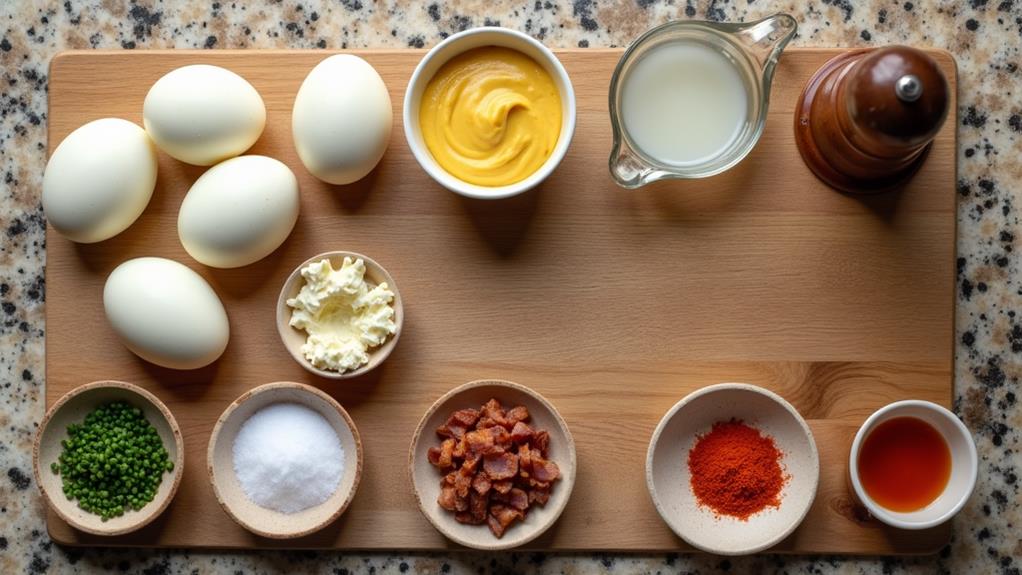You might not know that deviled eggs date back to ancient Rome, where they were served as a delicacy at feasts. Today, they've become a staple for gatherings and picnics, yet there's more to their appeal than just nostalgia. Their creamy filling and versatility allow for endless variations, making them a canvas for culinary creativity. As you consider the different ways to prepare this classic dish, you may find yourself contemplating the balance between tradition and innovation in your own kitchen.
Key Takeaways
- Deviled eggs are a classic appetizer made by mixing hard-boiled egg yolks with mayonnaise and spices, then filling the egg whites.
- The dish originated in ancient Rome and gained popularity in the 18th century, particularly in the United States during the 1940s and 1950s.
- A basic recipe requires 6 large eggs, mayonnaise, Dijon mustard, vinegar, salt, and pepper, with optional garnishes like paprika and chives.
- Preparation involves boiling the eggs, cooling them in an ice bath, mixing the yolks with other ingredients, and refilling the whites.
- Deviled eggs can be customized with various ingredients like bacon or jalapeños and can be made up to two days in advance.
History
Deviled eggs have a fascinating history that dates back to ancient Rome, where people seasoned boiled eggs and served them as appetizers. Can you imagine enjoying these tasty bites at a Roman feast?
The term "deviled" really took off in the 18th century, referring to the use of spicy seasonings that made dishes pop with flavor, including our beloved stuffed eggs.
As time went on, traditional recipes for deviled eggs found their way into American cookbooks in the late 19th century, becoming a must-have at social gatherings.
By the 1940s and 1950s, deviled eggs transformed into a staple at picnics, potlucks, and holiday celebrations, making their presence known at family gatherings and community events.
You'll find that variations of deviled eggs have emerged worldwide, showcasing diverse ingredients and flavors that reflect regional culinary preferences.
Whether it's a dash of hot sauce or a sprinkle of herbs, each twist adds a unique flair to this classic dish.
Recipe

Deviled eggs are a classic appetizer that brings a delightful combination of creaminess and flavor to any gathering. With their vibrant yellow yolk filling and tender egg whites, they aren't only visually appealing but also versatile enough to suit various palates. The process of making deviled eggs is simple and can be done in just a few steps, making them an ideal choice for both novice cooks and seasoned chefs alike.
To start, you'll need to hard-boil your eggs to achieve the perfect texture. Cooling them in an ice water bath is crucial to prevent overcooking, which can lead to unattractive gray-green rings around the yolks. Once cooled, the eggs can be sliced, and the yolks mixed with a creamy blend of mayonnaise and spices for a rich filling. Customize your deviled eggs with unique flavors to impress your guests or to cater to different tastes.
Ingredients:
- 6 large eggs
- 1/4 cup mayonnaise
- 1 teaspoon Dijon mustard
- 1 teaspoon vinegar (white or apple cider)
- Salt and pepper to taste
- Optional garnishes (paprika, chives, bacon bits, sriracha)
To prepare the deviled eggs, begin by placing the eggs in a saucepan and covering them with cold water. Bring the water to a boil over medium-high heat, then cover the pan and remove it from the heat. Let the eggs sit for about 12-14 minutes.
Once done, transfer the eggs to an ice water bath for about 5-10 minutes to cool. Once cooled, peel the eggs, slice them in half lengthwise, and carefully remove the yolks. In a mixing bowl, combine the yolks with mayonnaise, Dijon mustard, vinegar, salt, and pepper, and mash with a fork until smooth. Spoon or pipe the yolk mixture back into the egg whites and garnish as desired.
When preparing deviled eggs, it's important to ascertain that your eggs are fresh for the best flavor and texture. If you're making them in advance, store them in a sealed container in the refrigerator to maintain their freshness.
You can also experiment with different seasonings and mix-ins, such as adding pickle relish for extra tang or incorporating avocado for a healthier twist.
Similar dishes include egg salad, where chopped hard-boiled eggs are mixed with mayonnaise and various seasonings, or stuffed eggs, which can contain a variety of fillings. Variations of deviled eggs can also include ingredients like curry powder, jalapeños, or even smoked salmon for an upscale touch.
Final Notes
When preparing deviled eggs, remember that presentation and flavor are key to making a lasting impression. Your classic recipe can be easily elevated by mixing the egg yolks with creamy mayonnaise, a hint of Dijon mustard, and a splash of apple cider vinegar. This combination not only enhances the flavor but also adds a delightful tang.
For a stunning presentation, use a piping bag to fill the egg whites. It transforms your deviled eggs from simple to spectacular!
Don't forget about the magic of paprika for that eye-catching finish. But why stop there? Explore creative variations by adding ingredients like crispy bacon, spicy jalapeños, or fresh herbs such as dill and chives. These additions can take your deviled eggs to new heights and impress your guests.
You can make these treats ahead of time—up to two days in advance! Just store them in an airtight container in the fridge for peak freshness.
With the right balance of innovation and tradition, your deviled eggs will be the star of any gathering. Get ready to enjoy the compliments that come your way!
